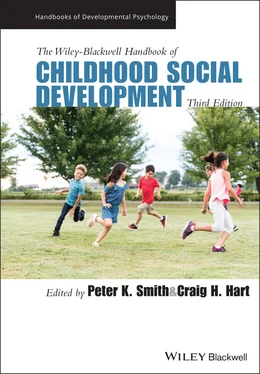In particular, the creation of multivariate statistical tools such as structural equations models (SEM; Jöreskog & Sörbom, 1979) furthered this transition by providing researchers with a means for evaluating complex networks of relations among multiple constructs across multiple occasions (i.e., both within and across time). Moreover, the algorithms contained in these tools (i.e., measurement models) allowed for the estimation of unobserved latent variables and, accordingly, provided investigators strategies for addressing critical measurement objectives such as improving construct specification and validity and evaluating and reducing measurement error (MacCallum & Austin, 2000).
One consequence of these developments was that researchers incorporated larger numbers of variables into their longitudinal investigations. Another was that they began to propose and test more complex patterns of construct relations (e.g., stability, invariance, independence/collinearity of constructs; direct and indirect effects; mediated, moderated, and cross‐lagged associations) that corresponded to (and provided a test of) hypotheses about developmental processes, mechanisms, pathways of influence, and so on.
Full‐panel prospective longitudinal designs increasingly were utilized because the data generated were well‐suited for evaluating hypotheses about emergent, shifting, and continuing pathways of influence among constructs (e.g., stabilities, alternative directions of effect, bidirectional effects, mediated effects, transactions) as specified within developmental process models. Investigators who utilized these designs assessed all focal constructs plus relevant covariates (e.g., control variables) at all times of measurement (i.e., repeatedly across assessment waves) and often relied on statistical tools such as cross‐lag panel models (CLPM; Kenny & Harackiewicz, 1979) to analyze their data. Among the advantages of CLPM, relative to its multivariate forerunners (e.g., multiple regression, path analysis) was the ability to construct and utilize latent variables, estimate multiple pathways over time including mediated pathways, and simultaneously estimate alternative directions of effects.
Other, more recent analytic innovations improved researchers’ ability to describe, distinguish, and quantify intra‐individual (within‐person) growth patterns (i.e., trajectories). Scientists used tools such as latent growth modeling (LGM; Bollen & Curran, 2006; Meredith, & Tisak, 1990) to map developmental trajectories and index specific trajectory parameters (e.g., initial status, shape or contour, and direction of change over time) for many dimensions of social development. Common applications included using LGM to: (a) contrast the growth trajectories of different classes of children (e.g., individuals manifesting different temperamental or behavioral characteristics); (b) assess whether growth on one variable was related to growth on another variable (trajectory covariance); (c) determine whether particular background variables (e.g., organismic or contextual factors) predicted specific aspects of children’s trajectories (e.g., rate of growth); and (d) test hypotheses about developmental continuities and discontinuities.
Among the latest advances made in the analysis of longitudinal panel data stem from tools such as Latent Curve Model with Structured Residuals (LCM‐SR, Curran et al., 2014), Autoregressive Latent Trajectory with Structured Residuals (ALT‐SR, Berry & Willoughby, 2017), and Random Intercept Cross‐Lag Panel Model (RI‐CLPM; Hamaker et al., 2015). Developmental scientists began to utilize these tools because they overcame a basic limitation inherent within CLPM: the aggregation of between‐person and within‐person covariance (Berry & Willoughby, 2017; Curran et al., 2014).
CLPM proliferated because it offered researchers an analytic framework for testing hypotheses about alternative pathways of influence (e.g., by simultaneously estimating cross‐lagged associations among constructs). Eventually, however, questions arose about the reliability of CLPM findings. Principally, criticism stemmed from the fact that, due to the aggregation of between‐person and within‐person covariance, significant cross‐lagged paths could emerge absent of any systemic within‐person increases or decreases in the predicted variable. This being the case, it was argued that CLPM could overestimate (or underestimate) cross‐lagged paths and thereby cause investigators to misinterpret the nature and strength of predictive links.
Strategies such as ALT‐SR overcame this limitation by utilizing repeated measurements to apportion the variance of each variable to stable between‐person differences (i.e., a latent intercept), between‐person differences in linear change (i.e., latent slope), and within‐person deviations from the estimated linear trajectory (i.e., structured residuals). Covariances between latent intercepts reflect stable between‐person associations, potentially due to unmeasured covariates or patterns established earlier in development. Cross‐lagged associations between structured residuals indicate that deviation from one’s developmental trajectory on one variable (e.g., an increase over and above what would be expected) is predictive of deviation from one’s developmental trajectory on a second variable at a subsequent time point (e.g., a decrease relative to what would be expected). Thus, unlike CLPM, these newer analytic tools provided researchers with a means of isolating within‐person changes and testing hypothesized predictors of within‐person increases and decreases.
Summary and Additional Considerations
Over the past half‐century, important advances were achieved on many fronts in research on social development. These accomplishments, as reviewed in relation to four overarching aims, not only laid the groundwork for contemporary knowledge about social development but also influenced the course of current and future research. Moreover, the progress described within these research mainstreams attests to the discipline’s ever‐expanding breadth, depth, and complexity.
Theoretical and methodological innovations were defining characteristics of the modern and near‐contemporary eras. Substantial shifts occurred in the conceptual frameworks that were proposed, tested, and revised and in the modes of inquiry and statistical tools that were used to gather, analyze, and interpret data. Collectively, these innovations transformed nearly every aspect of scientific endeavor including the conceptualization of social developmental phenomena, the formulation of research aims and hypotheses, the design of investigations, the analysis and interpretation of empirical data, and ultimately, the expansion of knowledge.
The discipline also was transformed by the many methodological and analytic advances that occurred throughout the modern and near‐contemporary eras. In addition to those detailed above, other significant innovations shaped the discipline’s progress. Although not a comprehensive account, the following deserve mention. Great strides were made in the development and utilization of neurobiological and psychophysiological assessments (Adrian et al., 2011; Vaillancourt, 2018). The use of these tools became widespread and not only extended existing lines of inquiry but also precipitated new avenues of investigation. Refinements in twin‐study methodologies advanced knowledge about genetic‐environmental contributions to children’s social development (Brendgen, 2014; Boivin et al. 2013), as did progress in molecular genetic research, including technology that enabled the identification of specific genes and gene–environment interactions (Caspi et al., 2002; Rutter, 2006). The emergence of social network theory, and associated measurement and analytic innovations, added a new dimension to research on the social structure and organization of children’s peer groups (Burk et al., 2007; DeLay et al., 2021). Multilevel modeling (Raudenbush & Bryk, 2002) influenced the way developmental scientists analyzed nested or clustered data, such as when variable relations (e.g., strength of association, predictive efficacy) were hypothesized to differ by social contexts or strata (e.g., categorical variables such as schools, socio‐economic status [SES] groups).
Читать дальше












